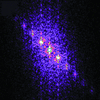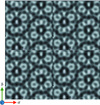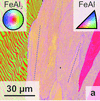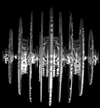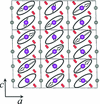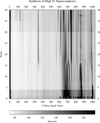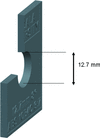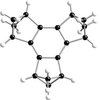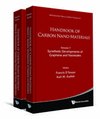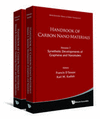issue contents
April 2016 issue

Cover illustration: Reconstructed diffraction volume for three units of tobacco mosaic virus (TMV), showing the pattern of layered discs spaced by 2![[pi]](/logos/entities/pi_rmgif.gif) /c (c is the length of the repeat unit of TMV). Courtesy of M. Uddin [J. Appl. Cryst. (2016), 49, 450-456].
/c (c is the length of the repeat unit of TMV). Courtesy of M. Uddin [J. Appl. Cryst. (2016), 49, 450-456].
research papers
A least-squares full-pattern analysis of the wavelength-dependent neutron transmission of mosaic crystals provides precise values of the spatial variation of lattice parameters, orientation, mosaicity and extinction factors in macroscopic specimens.
This paper concerns the investigation through small-angle X-ray scattering (SAXS) experiments of the aggregation process in polymeric solutions used for the elaboration of nanosized tin oxide crystals. This paper is part of a larger study focused on the determination of aggregation mechanisms of gelation of polymeric solutions. All the SAXS measurements have been performed in situ on the BM02 beamline at the ESRF.
The ferroelectric domain structure of 30 nm thin K0.75Na0.25NbO3 films grown on (110) TbScO3 substrates using metal–organic chemical vapour deposition (MOCVD) was investigated with piezoresponse force microscopy and X-ray diffraction. A monoclinic MA phase (together with a 90° rotated variant) could be identified with a highly perfect periodic domain pattern of narrow lateral domains of 25 nm in size extending over several micrometres.
This work uses a novel synchrotron technique to characterize the distribution of Fe in chrysoberyl. The results show very good agreement on comparison of measurement and calculation to confirm the validity of this technique.
To help deal with the failure phenomena frequently encountered in the residual stress measurement of nickel aluminium bronze, a new approach based on the Bayesian model class framework is proposed to evaluate and improve the performance of current X-ray stress measurement analysis.
The current work investigates key aspects of the evolution of nano-bainite formation at low isothermal temperature during the early stages of the transformation in a high Si steel using neutron diffraction, transmission electron microscopy (TEM) and atom probe tomography (APT) techniques.
A check of the flat-field calibration of a CCD detector showed good agreement with the manufacturer's calibration. A position-specific effect was detected that requires an additional correction to scale diffraction data properly. The source of this effect is uncorrectable using the flat-field correction, leading to a modulation of sharp features.
A comparison of X-ray stress measurement methods is made, based on the unified fundamental equation. From the estimation of errors, the generalized cosα method can achieve good accuracy in triaxial stress measurement with three frames.
Download citation


Download citation


The structure of a complex pseudo-decagonal quasicrystal approximant PD1 was solved on the basis of the strong reflections of the known related structure PD2, and finally confirmed by three-dimensional rotation electron diffraction.
CCDC reference: 1445018
Open  access
access
 access
accessThe orientation relationship and interface plane of eutectoid FeAl and FeAl2 lamellae are investigated in detail and a crystallographic model is proposed.
A computational model for solving the structure of a helical virus using an X-ray free-electron laser is presented. The inner discontinuity of the viral genome provides a decisive clue regarding the rotationally invariant Fourier space constraint of the diffraction volume.
Lysozyme microcrystals in a matrix aligned three dimensionally by a magnetic field are shown to allow room-temperature structure determination at 1.8 Å.
The twin structures in CuO nanowires were systematically investigated by combining electron microscopy experiments and crystallographic calculation.
A design study is presented of a Laue lens as an optical component to be used in combination with an X-ray tube to produce a convergent beam for radiotherapy application. The use of convergent beams may result in a high precision of the dose delivery. To demonstrate the effectiveness of the proposed system, a custom-made Monte Carlo simulation code and the GAMOS code have been used.
Raman spectroscopy at high temperature has been applied to study in situ the microstructure of the solution in a Cs2O–B2O3–MoO3 growth system. The Raman spectra near the interface show that at the boundary an isomerization reaction from three- to four-coordinated boron occurred.
Open  access
access
 access
accessA new data-collection strategy for Xray diffraction computed tomography experiments is presented that allows, post experiment, a choice between temporal and spatial resolution.
Open  access
access
 access
accessExtraction of structure factor amplitudes from total scattering (Bragg + diffuse diffraction) data for local structure modeling remains a significant challenge, especially when considering time-of-flight measurements. Individual intensity contributions carry different statistical weights, with associated distinctive effects on data summation and correction. A comprehensive, statistically improved data analysis approach to correct and scale the complete volume of reciprocal space data in one step is described.
Microstructural correlation associated with the transformation from 5M to 7M martensite in an Ni–Mn–Ga alloy was revealed by electron backscatter diffraction measurements.
Download citation


Download citation


A detailed study has been carried out on the crystal structure and crystallographic organizations of martensite in Ni–Mn–Sb ferromagnetic multifunctional alloys, these being decisive factors for their magnetic field-induced properties. Complete information on these two issues has been worked out and is presented.
Download citation


Download citation


It is shown that the incommensurate magnetic structures of multiferroic MnWO4 (under a magnetic field Hb) and Mn0.90Co0.10WO4 present the same magnetic symmetry. A comparative study under the magnetic superspace formalism reveals differences in the anisotropy of their magnetic modulations, the understanding of which illustrates the relevance of the different magnetocrystalline anisotropies of Co and Mn ions in the structures.
There is a thickness dependence of optical constants for amorphous Si (a-Si) films in the range of 1.5–5.0 eV. A spectroscopic ellipsometry analysis indicates that continuous random networks are dominant in the a-Si films studied here.
Open  access
access
 access
accessNeutron diffraction experiments on nanocrystalline holmium suggest the absence of helifan(3/2) and helifan(2) structures at 50 K.
Download citation


Download citation


The thermo-physical properties of K3B6O10Br crystals along the principal directions were systematically investigated. These properties are of importance for its practical application at high average power laser output.
CCDC reference: 1448410
In this article, the adaptation of a previously introduced six-dimensional grain reconstruction framework to the case of deformation twinning in metallic alloys is described. The optimized procedure enables the detection and three-dimensional reconstruction of twin lamellae down to micrometre thickness and more accurate reconstruction of orientation maps at moderate levels of plastic deformation.
Download citation


Download citation


Diffraction measurements on multiferroic Ba2CoGe2O7 at room temperature with both hot and cold neutrons show that the scattered intensities detected at the positions of reflections forbidden in the tetragonal space group  are entirely due to multiple diffraction (the Renninger effect).
are entirely due to multiple diffraction (the Renninger effect).
CCDC reference: 1452233
Quantification of the amorphous phases in soil-related material micro-samples was achieved with an advantageous refinement methodology that carefully separates the instrumental profile parameters leaving a reduced number of sample-related parameters.
This article describes experimental work demonstrating how dark-field neutron imaging can provide quantitative characterization of structures in the micrometre range which are not amenable to direct real space resolution.
Download citation


Download citation


The phase diagram of K0.5Na0.5NbO3–Bi1/2Na1/2TiO3 is reported.
Five black carbon-based archaeological powders from Pompeii are fully characterized by using a combination of nondestructive techniques. Characterizing these heterogeneous samples in this way provides a practical demonstration of a methodology available to be used for the identification, quantification and mapping of the crystalline and amorphous phases coexisting in a single sample.
A stochastic approach to analyse X-ray results and other physical properties of polymers and polymer composites is presented.
Cut silver crystals were tested at the Institute Laue–Langevin. Rocking curves were taken at multiple energies and crystallographic orientations and fitted using the Darwin model. For each crystal, the Darwin model gave values for the mosaicities and the crystallite sizes that were not consistent with one another.
Open  access
access
 access
accessA multigrain indexing algorithm for use with samples comprising an arbitrary number of known or unknown phases is presented.
cryocrystallography papers
Open  access
access
 access
accessThe Structural Molecular Biology group at SSRL has upgraded its crystal mounting robot (SAM) to enable a sample pin exchange time of approximately 25 s during automated screening of samples.
short communications
An ellipsoidal single-bounce monocapillary is employed to produce an annular X-ray beam, and the focal construct geometry high-intensity angular-dispersive X-ray diffraction technique is presented.
X-ray microdiffraction is used for acquiring microstrain distribution maps in polycrystalline thin films.
computer programs
A computer program for microscopy and microanalysis has been developed to convert electron diffraction patterns (rings) of multiple crystalline materials into X-ray diffraction patterns for analysis with X-ray diffraction software tools.
An online computing server, HBCS, has been developed to compute all potential hydrogen-bond interactions, with their distances and angles and their standard deviations, for a given macromolecular structure.
FIT2D, a general-purpose and specialist one- and two-dimensional data reduction and analysis program, is described.
The program COMPSTRU, available on the Bilbao Crystallographic Server (https://www.cryst.ehu.es), for the comparison of structures is presented. The utility of the program is discussed and illustrated with several examples.
Open  access
access
 access
accessThis article describes software for fast model reconstruction from small-angle scattering data, providing real-time feedback on experiments.
The software used to analyze data produced at the Linac Coherent Light Source X-ray free-electron laser is described.
Open  access
access
 access
accessDevelopments in the CrystFEL software suite, for processing diffraction data from `serial crystallography' experiments, are described.
The second updated version of the program DENFERT is introduced for ab initio biomacromolecular shape restorations from small-angle scattering data. The two major improvements concern the ability to treat small-angle neutron scattering data sets and the proper consideration of biomolecular hydration during the entire shape restoration procedure.
laboratory notes
Apertures for small-angle neutron scattering experiments and other precision components can be prepared with boron carbide/polymer composites by three-dimensional printing. Use of a 10B-enriched material gives a low level of background scattering.
A method is described for attaching gold fiducial markers to samples for X-ray measurements.
A system is presented for positioning powder samples in top-loading cryofurnaces during neutron scattering experiments while delivering set quantities of gases at set temperatures to the sample. The positioning system separates into an upper and a lower section, and the lower section can be inserted into a glove box for loading and sealing of a sample without exposing it to air.
addenda and errata
Free 

An incorrect statement in the paper by Gerelli [J. Appl. Cryst. (2016), 49, 330–339] is corrected.
Free 

Errors in the paper by Michels-Clark, Lynch, Hoffmann, Hauser, Weber, Harrison & Bürgi [J. Appl. Cryst. (2013), 46, 1616–1625] are corrected.
Free 

Errors in the article by Nayak, Pradhan & Lodha [J. Appl. Cryst. (2015), 48, 786–796] are corrected.
crystallographers
Free 

book reviews
Free 

Free 



 journal menu
journal menu










